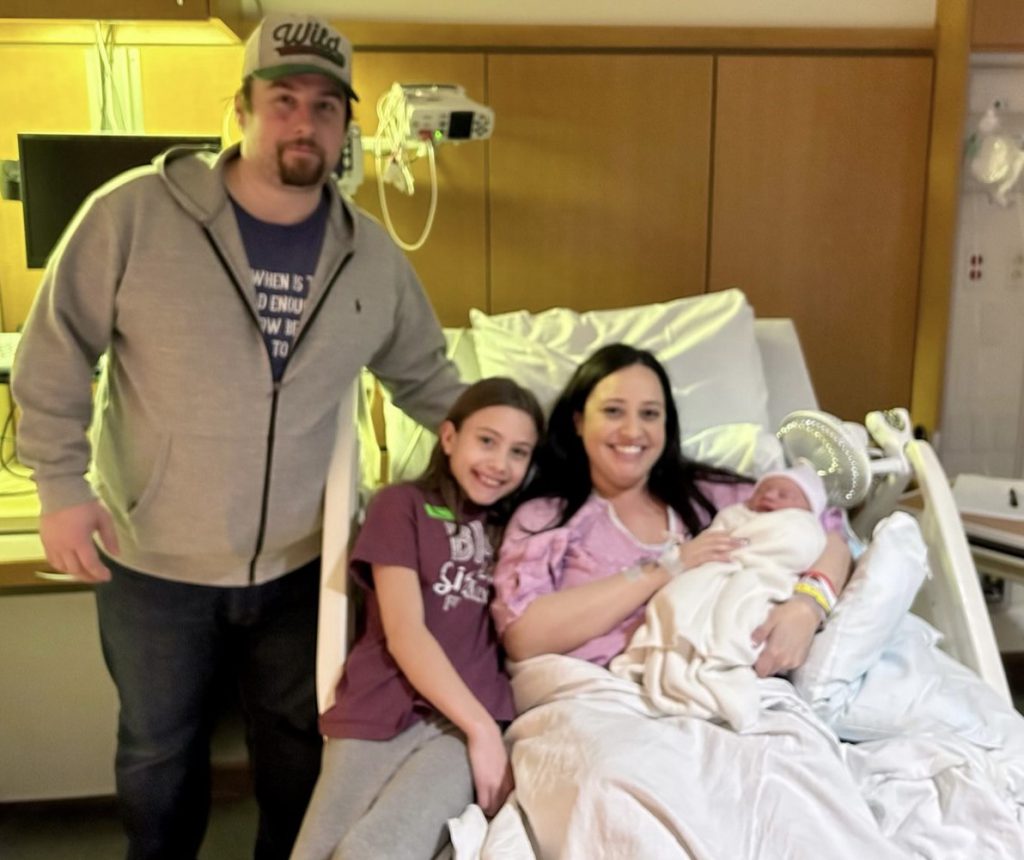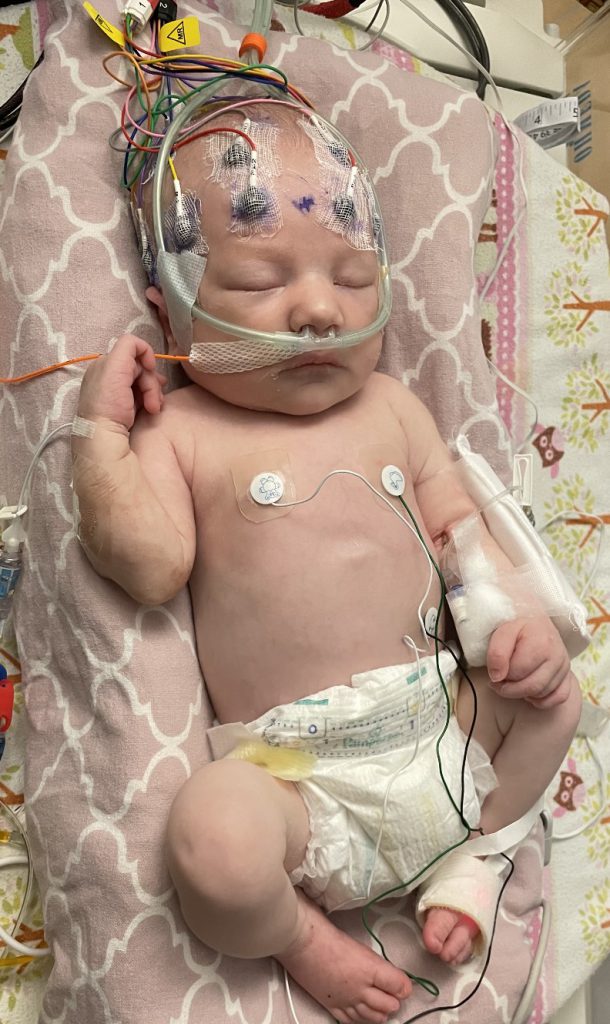For the lucky ones who’ve heard it, Diana’s bursts of laughter are a jolt of joy. For the 6-month-old baby and her family, knowing that this little one has the ability to hear anything out of both of her ears at all – is priceless.
Diana was born in February 2023, and she then passed her early health checks before she was sent home. The routine exam included a hearing test she passed for both ears with no red flags. The first night home would soon lead to many worry-filled nights for the newborn’s parents, Crystal and Justin Strohm. It started when the Strohms noticed their baby had a fever hovering around 100 degrees. The next day during the afternoon, after Diana’s first check-up, she was lethargic and wasn’t eating.
“We couldn’t get her to wake up at all, you could tell something was off – it was scary,” Crystal recalled.

That fear grew when Diana did not improve, so the parents took her back to her pediatrician for the second time in as many days. This time, an ambulance rushed Diana to the emergency department at Children’s Minnesota in Minneapolis because of her lowering blood oxygen levels.
A rare diagnosis
While in the emergency department, Diana’s care team performed a variety of tests to determine what was causing her alarming symptoms. A spinal tap revealed she had meningitis, an infection in the lining that covers the brain and spinal cord. Additional tests over the next couple days revealed she had a rare – and potentially life-threatening – form called bacterial meningitis.
Antibiotics treated her infection, but her battle was just beginning. Diana spent nearly six weeks combined in the neonatal intensive care unit (NICU) and infant care center (ICC) at Children’s Minnesota in Minneapolis.
“There is nothing that can make it better except the people that are there,” Justin said about his daughter’s care team. “Even those who were not our doctors or nurses, they were still there for us – everybody was amazing.”
More challenges
Diana’s care team also discovered she was having subclinical seizures. This diagnosis meant the newborn was having seizures with symptoms that could not be seen by the eye alone. Instead, the seizures could only be detected by an electroencephalogram (EEG) device that monitored the baby’s brainwaves.
“They couldn’t get them to stop. At the heaviest point, she was on five different medications,” Crystal explained. “She was so heavily sedated she was almost unconscious the first three weeks of her life to control the seizures.”
In the midst of combatting Diana’s seizures, her care team discovered she had another condition called, hydrocephalus. This meant a buildup of cerebrospinal fluid (CSF) had occurred within the hollow places inside her developing brain, called ventricles. It could create a dangerous amount of pressure inside her skull.

The Strohm family worked with Dr. Kyle Halvorson, pediatric neurosurgeon at Children’s Minnesota, and the Children’s Minnesota neurosurgery team to create a comprehensive care plan. As the family prepared for brain surgery, they were thrown another curveball when they learned Diana likely lost hearing in her right ear because of the meningitis.
During Diana’s delicate brain surgery, Dr. Halvorson and his team placed a special tube, called a shunt, from her brain’s ventricles to the space inside her belly where the stomach and bowels sit. The tube was placed under Diana’s skin and allows any extra CSF to be absorbed into her bloodstream. It was the first of several procedures for the infant.
Diana makes Minnesota medical history
After only four weeks of recovering from brain surgery, Diana would need to have another procedure to hear again in her right ear. Dr. Asitha Jayawardena, pediatric otolaryngologist with the ear, nose and throat (ENT) program at Children’s Minnesota, discussed options with the family. Dr. Jayawardena recommended placing a cochlear implant inside the infant’s inner ear. The hearing device turns sound vibrations into electrical signals which the brain translates into recognizable sounds.
“Dr. Jayawardena was fantastic,” Justin said. “For us it was weird because on one hand you want to play it safe to give her the best chance to hear – on the other hand you don’t want to give her another surgery during the first two months of her life.”
Time was critical because there was only a small window for Dr. Jayawardena to place the cochlear implant before the part of Diana’s inner ear, called the cochlea, permanently closed. After careful consideration and planning with the baby’s care team, Diana had the surgery when she was only about 10-weeks-old. This made her the youngest patient in Minnesota – and the second-youngest patient in the country – to ever have the procedure.
Activation day
In July 2023, Dr. Jayawardena and Jesi Novak, Au.D., pediatric audiologist at Children’s Minnesota, successfully activated Diana’s cochlear implant. Surrounded by her parents and big sister, the little one once again could hear with both ears.
“I thought it was beautiful, you could see her eyes get super wide and look around,” Crystal recalled. “You could tell she could hear something in her right ear, it was just an innocent beautiful moment for her.”
Diana’s dad also shared his memories of the moment, “for me it was a relief, a feeling of ‘this is working and it’s done, and now we don’t have to second guess or worry about decisions because it’s done.’”
Continued care
Diana’s clinical journey did not end during her cochlear implant activation. She’ll continue seeing Dr. Halvorson and the neurosurgery team at Children’s Minnesota to monitor her shunt. Diana will also undergo follow up care with The Kid Experts® at Children’s Minnesota in clinical specialty areas such as physical therapy, audiology and neurology; along with treatment for a rare disorder called infantile spasms seizures.
“The consistency of the care is incredible,” Justin said. “We wouldn’t go anywhere else.”
Crystal added, “the doctors and nurses at Children’s Minnesota saved her life and we can’t thank them enough for doing that.”
Diana’s family wants to share her story to help spread hope and awareness to families who encounter a similar meningitis diagnosis at such a young age – hope that can be symbolized by baby Diana hearing her own precious laughs from both ears once again.
